| Dalkey Tidy Towns |
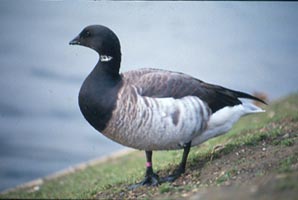 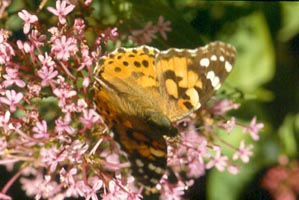 |
| Dalkey Tidy Towns |
  |
Wildlife
Newsletter for the Township of Dalkey June 2010 - Michael Ryan |
|
LATE EARLY ARRIVAL |
|
| Multi-tasking
Blackbird Even before the longest day on 21st June many of our songbirds will have stopped singing. Birds that overwinter here, would have began singing in late winter or early spring when the days were short and cold and by mid summer they won’t be looking for a mate or defending territory, they’ll have stopped singing because they’ll be too busy feeding their offspring. I always feel a little sad when the evening’s birdsong grows quieter. Although all our migrant songsters, Blackcaps, Chiffchaffs and Willow Warblers, which would have arrived in late spring, will still be singing in woodland and hopefully the happy chattering of Swallows and high pitched call of the swift will be filling warm skies, the very tuneful birds that see out the setting sun, Song Thrushes, Blackbirds and Robins will mostly have fallen quiet by idsummer. Although Robins and even Song Thrushes will begin to sing again during the winter the Blackbird won’t be heard again till next spring. This year we had a pair of blackbirds nesting in the hedge at the bottom of the garden with the male blackbird singing from the adjoining cherry tree before flying down into the hedge with food for its mate or its chicks. Maybe it happens all the time, nobody bothers mentioning it and I just hadn’t noticed it before but one evening I noticed the male blackbird was singing, while at the same time it still had food held between its open bill. It was holding a worm or a grub while it poured out a lovely melodious song. Since birds aren’t using their mouths to shape their words as we do, all the sounds are formed in their throat; the bill just has to be open to let the sound out. I thought it might have been a particularly busy day for the bird but it was doing the same the following evening this time with a bill full of insects. There’s another Blackbird with a territory very close to this one and our one seems obliged to compete against it every time it sings even with his mouth full. |
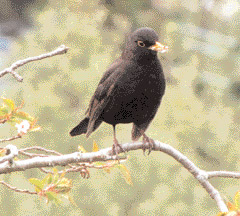 Blackbird Photo: Michael Ryan |
Dalkey’s Island Visitors Last
year was the 14th year of the Dalkey Tern Project and sadly the first year
we didn’t have any terns nesting successfully. Terns migrate back to
Irish waters after wintering off West Africa, some Arctic terns even going
down into the south Antarctic waters. The rock on which they nest in Dalkey,
Maiden’s Rock, the farthest left outcrop of rock from the main island
would be fine for them to nest on undisturbed by gulls, humans and any other
mammals but they are vulnerable to the threat of north easterly storms when
the sea can wash over the rock and sadly after one particularly bad storm
in early summer last year, made worse by the fact it coincided with a high
tide, the birds totally deserted the area. Undoubtedly they went to nest
somewhere else, on Rockabill or on the nesting platforms in Dublin Port but
it was a big disappointment for everyone involved to have the rock deserted
for the nesting season. |
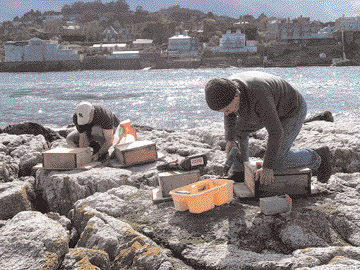 Volunteers
Fixing Tern Nesting Boxes on Dalkey Island Volunteers
Fixing Tern Nesting Boxes on Dalkey IslandPhoto: Natalia Borodina |
| Anyhow, we know some Arctic, Common and Roseate Terns are faithful to their nest sites in Dalkey and we do what we can to make their nesting area safer and more secure. This year we’re hoping the weather will be a bit kinder but we planned on doing whatever we could do anyway to stop their nesting sites being washed away. On the May Bank Holiday Monday we went over in an inflatable from Colimore, taking a couple of trips to bring over nestboxes, with rocks and cement slabs to weigh them down and a cordless drill to fix the boxes on to the rock. We also brought over 75 kilos of small stones and gravel for the terns to lay their eggs on. It can be difficult unloading boxes and bags of stones onto slippy rocks but the tide was high, the sea wasn’t too choppy and once we got everything landed it was even hot in the sunshine despite the northerly wind. We fixed the boxes on to the rock, weighed them down with the cement slabs and spread the gravel where the birds were likely to nest. We put numbers on the boxes that we can use for reference when viewing them from the land |
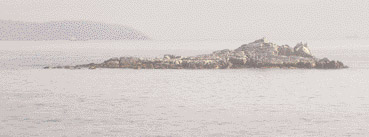 Coliemore Harbour: ‘Maiden’s Rock, Dalkey’ Photo: Michael Ryan |
. We try to number them in sequence from left to right but we gave one box the number 21 since anytime we’ve had Roseate Terns nesting there they’ve always nested in box 21 and we’re hoping they’ll remember the address! We got everything done and, hoping for the best, we returned to land, possibly the first time in 15 years I didn’t come back with socks and shoes soaking wet. We’ll be having viewing evenings from Colimore on the four Tuesdays of July and even though there will be lots of seabirds and seals to look at around the island we’re hoping we’ll have a few families of terns to show to people. |
|
Swifts
traditionally arrive at the beginning of May, one of the last summer migrants
to arrive, but this year there were a few over Dalkey at the end of April,
possibly brought on the southerly winds that had been blowing for a few days
beforehand. Another interesting sighting was a red squirrel that someone
saw treading along the electric cable over the main |